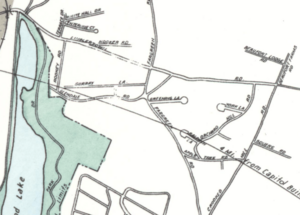Beaufort Farms, Pennsylvania facts for kids
Quick facts for kids
Beaufort Farms
|
|
|---|---|
| Country | United States |
| State | Pennsylvania |
| County | Dauphin |
| Townships | Susquehanna |
| Elevation | 577 ft (176 m) |
| Time zone | UTC-5 (Eastern (EST)) |
| • Summer (DST) | UTC-4 (EDT) |
| ZIP codes |
17110
|
| Area codes | 717 and 223 |
Beaufort Farms (pronounced BOH-fərt) is a community in Susquehanna Township, Dauphin County, Pennsylvania. It is part of the larger Harrisburg–Carlisle area. This place used to be a large farmland. Today, it is a developed area with many neighborhoods. In the past, it was also known as Beaufort or Calder Farms.
Contents
History of Beaufort Farms
How Beaufort Farms Began
William Calder Sr. moved to Harrisburg in 1812. He came from a well-known family in Dauphin County. He became very successful in the business of running stagecoaches. These were like old-time buses pulled by horses. But his favorite thing to do was farming and raising animals.
In 1851, his son, William Jr., took over the family businesses. By 1879, the Calder family owned seven farms near Harrisburg. These farms covered about 900 acres. They were known as Calder Farms.
William Calder Jr. later helped start a big company. It was called the Harrisburg Car Manufacturing Company. This company made rolling stock, which are parts for trains. It became one of the most important industrial companies of its time.
The Mitchell Family and the Land
In 1892, Ehrman B. Mitchell Sr. married William Calder Jr.'s daughter. They later inherited the land. A man named John S. Reichert lived on the farm and took care of it full-time. Reichert Road was named after him.
In the 1890s, streetcar lines started to reach out from Harrisburg. This made it easier for people to travel. Many farmlands owned by Harrisburg businessmen were then divided. They were planned for future neighborhoods.
When Ehrman Mitchell Sr. passed away in 1913, his children inherited the land. Ehrman Mitchell II kept the land as a successful dairy and fruit farm. The farm was close to the Pennsylvania Canal. This helped them deliver milk directly to customers. It was the only farm doing this at the time.
The Beaufort Hunt Club
In 1929, Ehrman B. Mitchell II started a special club. It was called the American Beaufort Hunt. This was a fox hunting club. He got special permission to use the name "Beaufort." This name came from a famous hunt club in England.
Developing the Neighborhoods
By 1947, Ehrman Mitchell II was not in good health. He saw his fruit orchards going to waste. He decided to turn the land into a residential area. This meant selling parts of the land for homes.
In 1947, Ehrman Mitchell II and his sister announced their plans. They would sell lots of land for people to build houses. Buyers could design their own homes. But the designs had to be approved. If you bought a lot over an acre, you could even keep farm animals!
Eighty acres of the land were put up for sale first. The first streets, Orchard Hill Road and Apple Tree Road, were paved. By early 1948, 15 plots of land were already sold. Through the 1950s, more land was sold to developers. They planned and built more neighborhoods. New neighborhoods and subdivisions continue to be built on the land today.
Geography of Beaufort Farms
Beaufort Farms is located in a specific part of the township. It is generally bordered by Linglestown Road to the north. Crooked Hill Road is to the east. Windsor Farms or Montfort Drive is to the south. U.S. Route 322 and Wildwood Park are to the west.
Notable People from Beaufort Farms
- Ehrman Mitchell III
- Adam Resnick


